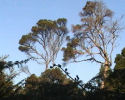 "Set aside by local farmers in the 1950s, the Waratah Bay section of Cape Liptrap Coastal Park has been free of fire for 80 years - regrowing fern gullies on old sand dunes with some very old bush high in the catchments of its myriad creeks. Sheltered from northerly winds the section from Waratah Bay to Bear Gully supports this now isolated bush, which in turn supports lyrebirds, wombats and bandicoots. It has not been the source of any fires for 80 years and it gets wetter as it gets older. It may be that we do not have to burn the bush all the time to be safe - in some cases burning the bush may increase its flammability and dry it out. Best to look before we burn - watch the video and write and ask for more time" writes Owen Roberts, under this video on youtube.
"Set aside by local farmers in the 1950s, the Waratah Bay section of Cape Liptrap Coastal Park has been free of fire for 80 years - regrowing fern gullies on old sand dunes with some very old bush high in the catchments of its myriad creeks. Sheltered from northerly winds the section from Waratah Bay to Bear Gully supports this now isolated bush, which in turn supports lyrebirds, wombats and bandicoots. It has not been the source of any fires for 80 years and it gets wetter as it gets older. It may be that we do not have to burn the bush all the time to be safe - in some cases burning the bush may increase its flammability and dry it out. Best to look before we burn - watch the video and write and ask for more time" writes Owen Roberts, under this video on youtube.You might also look at articles on candobetter.net about how old forests are wetter and rarely succumb to bushfires (otherwise they would not be old), e.g. in "Responding to incorrect fire information by joining the debate," and the role of coastal trees in creating wind to carry rainfall further inland at "Deforestation drys continents - new theory explains how."
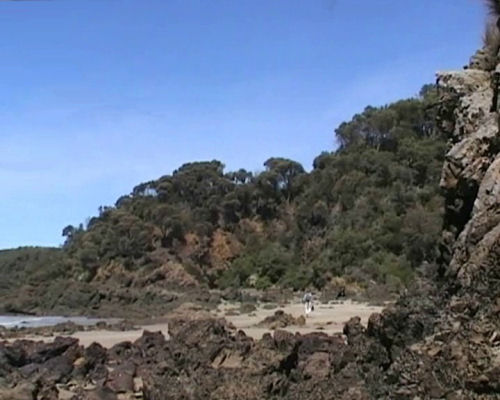
I have known this bushland between Waratah Bay and Bears Gully for something like 55 years. I have never seen it burn. It is a remarkably varied and beautiful piece of coastline, with well vegetated cliffs and meadows leading to large and small coves, each incredibly different from the next.
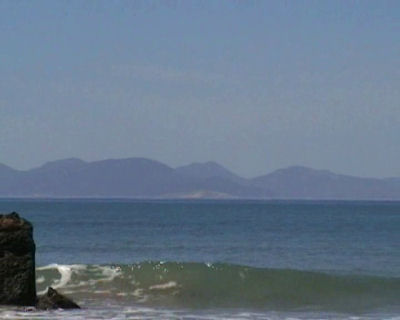
Across transparent water you can see Wilsons Prom in the form of soft purple hills. The sky is nearly always azure. At low tide you can walk to limestone islands and along the beach are jagged reefs with spines like stegosauruses, malachite-green rocks and others with iron-red crevices. Clay-pools with coloured streaks dribble down the cliffs. From beach to beach, the mineral content and the form of the pebbles, rocks and boulders changes frequently and suddenly, a reflection of the ancient upheaval of sedimentary rock. Burning the forest that cloaks this coastline would be a kind of insane pyromania, which is what we have, unfortunately, learned to fear from Victorian governments.
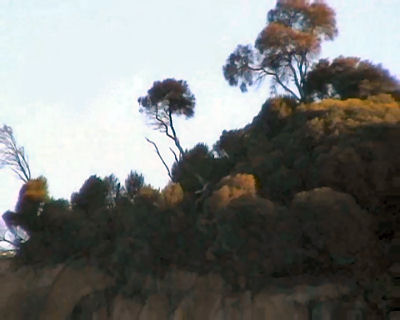
There are probably more sinister motives behind this kind of drive to burn that part of the coast, even if the actual rangers are in the dark: This area is the focus of land speculators. Developers are salivating over it. Already a number of agricultural properties have been turned into housing estates, retirement estates and holiday developments - none of which, incidentally, manage the rabbits - which at least the farmers did.
The developers cannot build where there is good forest, but if the forest burns, they will be able to pick it away at the edges and, in a few years, there won't be any more forest; just suburbs, rabbits, foxes, and erosion all the way down to the cliffs.
I note some blather about mosaic burns helping save wildlife in comments underneath the video featured here. These four articles about the result of planned burns in Wilsons Promontory just across the bay should destroy any faith in the sanity of mosaic burning in this area.
Owen Robert's film here makes excellent points about how mosaic burning and any fires that destroy bushland, kill native animals. Whilst those animals are absent, rabbits and foxes migrate into the vacated areas. Fires are an excellent way to destroy our native ecology. They seem to be a kind of religion that passes for science in that the clearing of fuel by fire ideology is extremely resistant to reason.
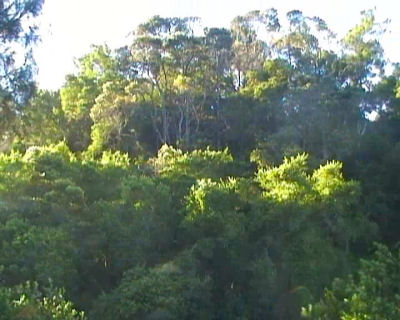
These mosaic fire apologists close their eyes to the fact that old forest rarely burns and burns are easier to control there than in new forests, especially forests which have evolved in response to human-made fires. If the consultants are being paid by government, then you can be sure that they will find a way to recommend fires. It is crazy, but seems to be true.
The author of the film above, asks that people write to [email protected]; [email protected], [email protected]; [email protected] and seek support for independent research by mycologists (fungi specialists) and entomologists (insect specialists) in the role of fungi and insects in breaking down fuel. It's a no brainer but Parks Victoria and other government agencies and hangers-on don't seem to be able to use their brains where fire and forests are concerned. You need to help them. You can write to the film-maker at eclectic.parrot[at]bigpond.com, or send a letter to Walk Fire Research, P.O> Box 305, Foster, 3960.

Comments
Sheila Newman
Tue, 2014-04-29 21:00
Permalink
Speaker: Fire, noxious gases, acid & heavy metaloids release
"FIRE NOXIOUS GASES, ACID AND HEAVY METALS & METALOIDS in your backyard"
Groundwater extraction, climate change and drought have massive implications for the groundwater dependent ecosystems found throughout the Otway Ranges. One impact with serious outcomes is the creation of Actual Acid Sulfate Soil sites. They can ruin farmland, swamps, rivers and streams through elevated acid load, production of
numerous toxins, heavy metals and noxious gases. Add fire to the mix and the problems are multiplied. The Otway Ranges and coastline have numerous Potential Acid sulfate Soil sites. Malcolm Gardiner. Vice President, LAWROC Landcare Group.
Prof. Richard Bush and associate Phil Hirst, have studied what can happen when one of the Otway Ranges
Potential Acid Sulfate Soil sites dries out and then catches fire. Come along and listen to Professor Bush present
their findings on the Big Swamp, Yeodene.
7:30 to 8 PM COPAC Civic Hall COLAC, Wednesday 14th May 2014.
Professor Richard Bush is a founding member and director of the Southern Cross University’s Geoscience Faculty. He is a Professor and Director of Higher Degree Research Training and from an international perspective cannot come more qualified to talk about Inland Acid Sulfate Soils. His research interests are soil science and soil water interactions in agricultural and urban landscapes.
Abstract of the Professor’s presentation.
New data from the Barwon River catchment in the Otway Ranges will be presented for the first time by Professor Bush and his team. This presentation will show drainage and wildfire can trigger severe acid sulfate degradation.
Immense challenges for current thinking on catchment management, water extraction and the conservation of landscapes will be demonstrated, including practical ideas on remediation and implications of the damage already done.
The findings of this work will be immensely interesting to regional communities and natural resource managers.
As President and on behalf of the LAWROC Landcare Group I cordially invite you to attend this rather auspicious occasion.
Patricia Jukes. President, LAWROC Landcare Group.
Add comment